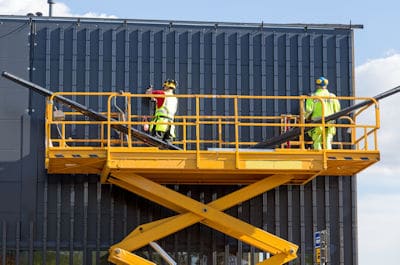Lifting Tables / Scissor Lifts

Scissor lifts are commonly observed as adaptable pieces of equipment that are best suited to raise or lower heavyweight goods over short distances. The distance the equipment may be able to carry the goods – as well as the load capacity – may vary depending on the brand and capabilities of the specific equipment purchased. The primary directions they are able to maneuver are up and down, although some models may be able to move a few feet horizontally.
Scissor lifts are also available in a selection of sizes to best serve particular projects. For instance, smaller versions tend to run on electric motors and be used in indoor workplaces, whereas larger lifts may be used on building sites or other similar settings and run on petrol, diesel, or hybrid engines. More on the differences between these will be discussed further below.
Common Uses Of Personnel Lifts
This type of equipment is specialized to be suitable for industrial processes in particular due to the equipment’s heavy-lifting capabilities. In many cases, scissor lifts serve as a replacement to the traditional use of a ladder. More so than ladders, capable lifting tables offer more secure stability, as well as convenience of heavy-lifting that ladders by themselves – i.e. without the assistance of a person – cannot perform.
Furthermore, lifting tables can offer more safety to those operating, which allows those workers utilizing the equipment’s to perform their jobs with more peace of mind. The most notable difference between scissor lifts and other material lifts is that scissor lifts are typically only capable of maneuvering materials in a vertical direction.
Common industries that utilize this type of equipment include those involved in the manufacturing of upholstered furniture, as well as woodworking, metalworking, transportation, warehousing and distribution, and heavy machinery.
There are a number of uses scissor lifts can best serve within these industrial processes. The most common include:
- Docking operations
- Vehicle loading
- Load positioning
- Mobility impaired access (electric recliners for elderly)
In addition, lifting tables can also be used as wheelchair lifts. However, it should be noted that any situations in which humans or other living beings are involved with lifting equipment processes should be undertaken with a high level of care.
Types of Scissor Lifts
While there are different types of scissor lifts available for industrial use – most commonly differentiated by the means through which they operate (i.e. electric motor, diesel, hand-powered) – they generally share similar characteristics such as those relayed above.
Their heavy-lifting capabilities, scissor-shaped mechanism, and common usage within a variety of industries tend to coincide. Certainly, larger lifts may be used for different projects than those which the smaller equipment are chosen for.
Diesel and electric-powered scissor lifts tend to be those most commonly used. However, while those that are electrically-powered tend to be preferred within enclosed spaces due to the potential fumes of those diesel-operated, gas or diesel lifts tend to be more highly favored for outdoor use.
In addition to differences that may be noted between how certain types of scissor lifts operated, so too may the lifts differ based on the industrial setting in which they are being utilized.
Slab Scissor Lifts
Slab scissor lifts are equipment often characterized by the comparatively low noise levels they can offer, large platform workspace for secure handling, and their ability to become relatively compact when stowed. These scissor lifts are also considered ideal for maneuvering around in tight areas where there is limited space for horizontal movement.
These may be particular recommended for electric installation, indoor decorating, warehouse operations, and for use by lighting contractors. These are known to be utilized within both indoor and outdoor settings for maintenance and installation purposes. Depending on the brand and model purchased, these lifts may be able to lift up to 1500 lbs of materials.
Rough Terrain Scissor Lifts
Some gas or diesel-powered scissor lifts for strenuous or challenging outdoor use are referred to as rough terrain scissor lifts. This is due to their particular suitability for outdoor use as characterized by their large stature and durable build.
These models may be particularly useful for outdoor construction, building maintenance, landscaping purposes, roofing contractors, and window cleaning as they can typically maneuver themselves and their loads through challenging terrain.
Aerial Work Platforms/Personnel Lifts
Lastly, there are smaller aerial work platforms oftentimes identified as personnel lifts. These are ideal to use in situations where space is limited, as they are designed to take up little width or horizontal space, instead having farther reach in their vertical extension. These lifts are recommended for ceiling work, retail/warehouse operations, and lighting work.
The contraction of the scissor mechanism at the extension piece of the equipment may be mechanical, hydraulic, or pneumatic. The use of these lifts is common for maintenance and construction work, as well as for firefighters for maneuvering purposes at great heights during emergency situations.
